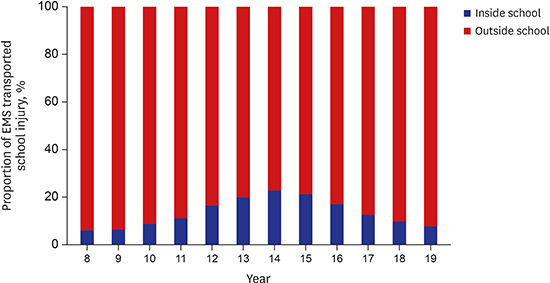1. Global Burden of Disease Pediatrics Collaboration. Global and national burden of diseases and injuries among children and adolescents between 1990 and 2013: findings from the global burden of disease 2013 study. JAMA Pediatr. 2016; 170(3):267–287.
2. Borse NN, Gilchrist J, Dellinger AM, Rudd RA, Ballesteros MF, Sleet DA. Unintentional childhood injuries in the United States: key findings from the CDC childhood injury report. J Safety Res. 2009; 40(1):71–74.

3. Peden M, Oyegbite K, Ozanne-Smith J, Hyder AA, Branche C, Rahman AK, et al. World Report on Child Injury Prevention. Geneva, Switzerland: World Health Organization;2008.
4. Statistics Korea. Annual Report on the Cause of Death Statistics. Daejon, Korea: Statistics Korea;2013.
5. Jung JH, Kim DK, Jang HY, Kwak YH. Epidemiology and regional distribution of pediatric unintentional emergency injury in Korea from 2010 to 2011. J Korean Med Sci. 2015; 30(11):1625–1630.

6. Rivara FP, Calonge N, Thompson RS. Population-based study of unintentional injury incidence and impact during childhood. Am J Public Health. 1989; 79(8):990–994.

7. Fang Y, Zhang X, Chen W, Lin F, Yuan M, Geng Z, et al. Epidemiological characteristics and burden of childhood and adolescent injuries: a survey of elementary and secondary students in Xiamen, China. BMC Public Health. 2015; 15(1):357.

8. Mytton J, Towner E, Brussoni M, Gray S. Unintentional injuries in school-aged children and adolescents: lessons from a systematic review of cohort studies. Inj Prev. 2009; 15(2):111–124.

9. Amanullah S, Heneghan JA, Steele DW, Mello MJ, Linakis JG. Emergency department visits resulting from intentional injury in and out of school. Pediatrics. 2014; 133(2):254–261.

10. Wahdan MM, Sayed AM, Abd Elaziz KM, El-Hoseiny MM, Al-Gwaily MM. Prevalence of injuries among high school students in Eastern and Western parts of Cairo, Egypt. Injury. 2016; 47(12):2650–2654.

11. Shin SD, Ong ME, Tanaka H, Ma MH, Nishiuchi T, Alsakaf O, et al. Comparison of emergency medical services systems across Pan-Asian countries: a Web-based survey. Prehosp Emerg Care. 2012; 16(4):477–496.

12. Lee SU, Suh D, Kim HB, Jung JH, Hong KJ, Lee JH, et al. Epidemiology of prehospital emergency medical service use in Korean children. Clin Exp Emerg Med. 2017; 4(2):102–108.

13. Ising A, Proescholdbell S, Harmon KJ, Sachdeva N, Marshall SW, Waller AE. Use of syndromic surveillance data to monitor poisonings and drug overdoses in state and local public health agencies. Inj Prev. 2016; 22:Suppl 1. i43–i49.

14. Park JO, Shin SD, Song KJ, Hong KJ, Kim J. Epidemiology of emergency medical services-assessed mass casualty incidents according to causes. J Korean Med Sci. 2016; 31(3):449–456.

15. Minei JP, Schmicker RH, Kerby JD, Stiell IG, Schreiber MA, Bulger E, et al. Severe traumatic injury: regional variation in incidence and outcome. Ann Surg. 2010; 252(1):149–157.
16. Barton DJ, Tift FW, Cournoyer LE, Vieth JT, Hudson KB. Acute alcohol use and injury patterns in young adult prehospital patients. Prehosp Emerg Care. 2016; 20(2):206–211.

17. Sun YH, Yu IT, Wong TW, Zhang Y, Fan YP, Guo SQ. Unintentional injuries at school in China--patterns and risk factors. Accid Anal Prev. 2006; 38(1):208–214.

18. Gratz RR. School injuries: what we know, what we need. J Pediatr Health Care. 1992; 6(5 Pt 1):256–262.

19. Scheidt PC, Harel Y, Trumble AC, Jones DH, Overpeck MD, Bijur PE. The epidemiology of nonfatal injuries among US children and youth. Am J Public Health. 1995; 85(7):932–938.

20. Di Scala C, Gallagher SS, Schneps SE. Causes and outcomes of pediatric injuries occurring at school. J Sch Health. 1997; 67(9):384–389.
21. Salminen S, Kurenniemi M, Råback M, Markkula J, Lounamaa A. School environment and school injuries. Front Public Health. 2014; 1:76.

22. Wilson M, Baker S. Structural approach to injury control. J Soc Issues. 1987; 43(2):73–86.

24. Hu GQ, Zhu SL, Wang QQ, Chen TM, Tan AC, He Q, et al. An epidemiological survey on the incidence of non-fatal injury and influencing factors among children under 5 years old in China. Zhonghua Liu Xing Bing Xue Za Zhi. 2011; 32(8):773–776.
25. Taketa S. Student accidents in Hawaii's public schools. J Sch Health. 1984; 54(5):208–209.

26. Feldman W, Woodward CA, Hodgson C, Harsanyi Z, Milner R, Feldman E. Prospective study of school injuries: incidence, types, related factors and initial management. Can Med Assoc J. 1983; 129(12):1279–1283.
27. Lenaway DD, Ambler AG, Beaudoin DE. The epidemiology of school-related injuries: new perspectives. Am J Prev Med. 1992; 8(3):193–198.

28. Linakis JG, Amanullah S, Mello MJ. Emergency department visits for injury in school-aged children in the United States: a comparison of nonfatal injuries occurring within and outside of the school environment. Acad Emerg Med. 2006; 13(5):567–570.

29. Harris CR, Jenkins M, Glaser D. Gender differences in risk assessment: why do women take fewer risks than men? Judgm Decis Mak. 2006; 1(1):48–63.
30. Coppens NM, Gentry LK. Video analysis of playground injury-risk situations. Res Nurs Health. 1991; 14(2):129–136.

31. Reinberg O, Lutz N, Reinberg A, Mechkouri M. Trauma does not happen at random. Predictable rhythm pattern of injury occurrence in a cohort of 15,110 children. J Pediatr Surg. 2005; 40(5):819–825.
32. Koch HJ, Vogel M, Raschka C. Circadian rhythm of accidents in children: a basic activity periodicity. Chronobiol Int. 2003; 20(1):157–159.
33. Shah MN, Cushman JT, Davis CO, Bazarian JJ, Auinger P, Friedman B. The epidemiology of emergency medical services use by children: an analysis of the National Hospital Ambulatory Medical Care Survey. Prehosp Emerg Care. 2008; 12(3):269–276.








 PDF
PDF Citation
Citation Print
Print






 XML Download
XML Download